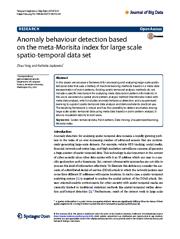A copy of this work was available on the public web and has been preserved in the Wayback Machine. The capture dates from 2019; you can also visit the original URL.
The file type is application/pdf.
Anomaly behaviour detection based on the meta-Morisita index for large scale spatio-temporal data set
2018
Journal of Big Data
Introduction Anomaly detection for analysing spatio-temporal data remains a rapidly growing problem in the wake of an ever-increasing number of advanced sensors that are continuously generating large-scale datasets. For example, vehicle GPS tracking, social media, financial network and router logs, and high resolution surveillance cameras all generate a huge amount of spatio-temporal data. This technology is also important in the context of cyber security since cyber data carries with it an IP
doi:10.1186/s40537-018-0133-8
fatcat:ojgglsl37zcr3fmoubhgjjxt74

